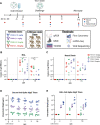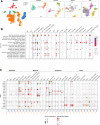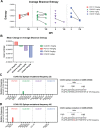This is a preprint.
Passive infusion of an S2-Stem broadly neutralizing antibody protects against SARS-CoV-2 infection and lower airway inflammation in rhesus macaques
- PMID: 39109178
- PMCID: PMC11302620
- DOI: 10.1101/2024.07.30.605768
Passive infusion of an S2-Stem broadly neutralizing antibody protects against SARS-CoV-2 infection and lower airway inflammation in rhesus macaques
Abstract
The continued evolution of SARS-CoV-2 variants capable of subverting vaccine and infection-induced immunity suggests the advantage of a broadly protective vaccine against betacoronaviruses (β-CoVs). Recent studies have isolated monoclonal antibodies (mAbs) from SARS-CoV-2 recovered-vaccinated donors capable of neutralizing many variants of SARS-CoV-2 and other β-CoVs. Many of these mAbs target the conserved S2 stem region of the SARS-CoV-2 spike protein, rather the receptor binding domain contained within S1 primarily targeted by current SARS-CoV-2 vaccines. One of these S2-directed mAbs, CC40.8, has demonstrated protective efficacy in small animal models against SARS-CoV-2 challenge. As the next step in the pre-clinical testing of S2-directed antibodies as a strategy to protect from SARS-CoV-2 infection, we evaluated the in vivo efficacy of CC40.8 in a clinically relevant non-human primate model by conducting passive antibody transfer to rhesus macaques (RM) followed by SARS-CoV-2 challenge. CC40.8 mAb was intravenously infused at 10mg/kg, 1mg/kg, or 0.1 mg/kg into groups (n=6) of RM, alongside one group that received a control antibody (PGT121). Viral loads in the lower airway were significantly reduced in animals receiving higher doses of CC40.8. We observed a significant reduction in inflammatory cytokines and macrophages within the lower airway of animals infused with 10mg/kg and 1mg/kg doses of CC40.8. Viral genome sequencing demonstrated a lack of escape mutations in the CC40.8 epitope. Collectively, these data demonstrate the protective efficiency of broadly neutralizing S2-targeting antibodies against SARS-CoV-2 infection within the lower airway while providing critical preclinical work necessary for the development of pan-β-CoV vaccines.
Conflict of interest statement
Conflicting Interests: RA, TFR, and DRB are listed as inventors on pending patent applications describing the SARS-CoV-2 and HCoV-HKU1 S cross-reactive antibodies. DRB and RA are listed as inventors on a pending patent application describing the S2 stem epitope immunogens identified in this study. DRB is a consultant for IAVI. All other authors declare that they have no competing interests.
Figures





Similar articles
-
A human antibody reveals a conserved site on beta-coronavirus spike proteins and confers protection against SARS-CoV-2 infection.bioRxiv [Preprint]. 2022 Jan 21:2021.03.30.437769. doi: 10.1101/2021.03.30.437769. bioRxiv. 2022. Update in: Sci Transl Med. 2022 Mar 23;14(637):eabi9215. doi: 10.1126/scitranslmed.abi9215. PMID: 33821273 Free PMC article. Updated. Preprint.
-
A human antibody reveals a conserved site on beta-coronavirus spike proteins and confers protection against SARS-CoV-2 infection.Sci Transl Med. 2022 Mar 23;14(637):eabi9215. doi: 10.1126/scitranslmed.abi9215. Epub 2022 Mar 23. Sci Transl Med. 2022. PMID: 35133175 Free PMC article.
-
Broadly neutralizing anti-S2 antibodies protect against all three human betacoronaviruses that cause deadly disease.Immunity. 2023 Mar 14;56(3):669-686.e7. doi: 10.1016/j.immuni.2023.02.005. Epub 2023 Feb 16. Immunity. 2023. PMID: 36889306 Free PMC article.
-
Novel S2 subunit-specific antibody with broad neutralizing activity against SARS-CoV-2 variants of concern.Front Immunol. 2023 Dec 8;14:1307693. doi: 10.3389/fimmu.2023.1307693. eCollection 2023. Front Immunol. 2023. PMID: 38143750 Free PMC article.
-
SARS-CoV-2 spike S2-specific neutralizing antibodies.Emerg Microbes Infect. 2023 Dec;12(2):2220582. doi: 10.1080/22221751.2023.2220582. Emerg Microbes Infect. 2023. PMID: 37254830 Free PMC article. Review.
References
Publication types
Grants and funding
LinkOut - more resources
Full Text Sources
Research Materials
Miscellaneous
